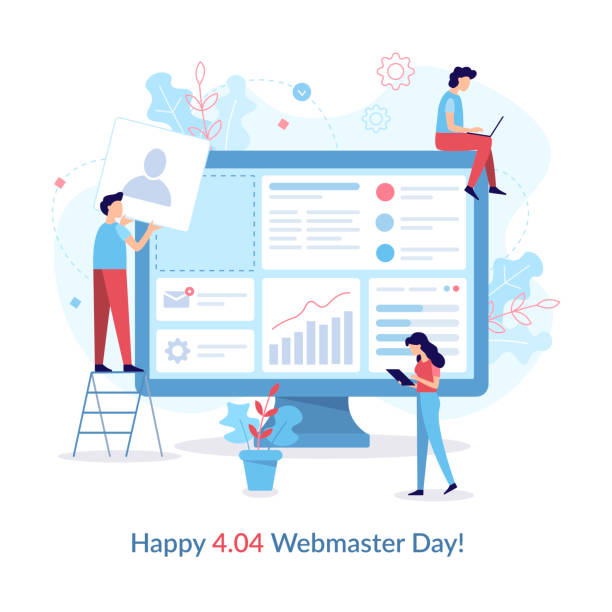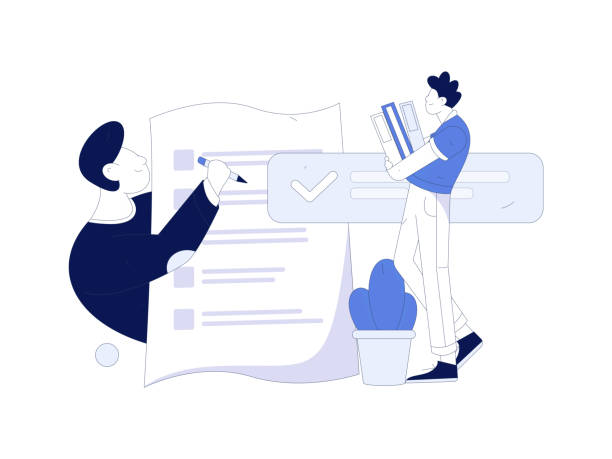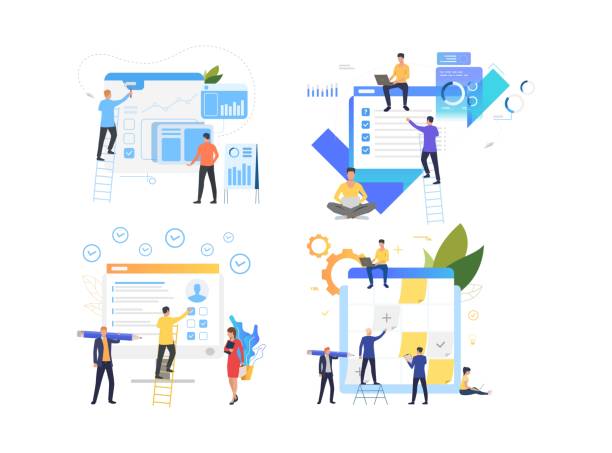The Importance of SEO-Optimized Website Design in the Digital Age

In today’s world, where virtual space has become an inseparable part of daily life and businesses, visibility among a multitude of websites is of vital importance.
This is where the concept of #SEO_Optimized_Website_Design comes in.
SEO-Optimized Website Design (SEO-Friendly Website Design) means building a website that is not only attractive and functional for users but also easily understandable and indexable by search engines like Google.
The main goal of this type of design is to achieve top rankings in search results to drive organic (free and targeted) traffic to the website.
This traffic can lead to increased sales, brand recognition, and online credibility.
Imagine you have a physical store; if this store is in a dead-end alley and out of sight, it will have no customers.
Your website is the same.
Without SEO, your website remains lost among billions of other pages.
This educational and explanatory approach in website design includes optimizing internal (on-page SEO) and external (off-page SEO) factors.
From clean and optimized coding structure to loading speed, mobile compatibility, and logical information architecture, all play a key role in the process of SEO-Optimized Website Design.
The more search engine-friendly your website is, the greater your chances of being seen and attracting your target audience.
This initial investment in optimized website design will bring long-term and sustainable returns that no paid advertising campaign alone can provide.
Are you losing potential customers due to an unprofessional website? Rasaweb is your answer! With our specialized corporate website design services:
✅ Enhance your business’s credibility and standing
✅ Experience attracting more targeted customers
⚡ Act now to receive a free consultation!
Technical Foundations of SEO-Centric Website Design

The #Technical_SEO section forms the foundation of every successful SEO-optimized website design.
Without a strong technical infrastructure, even the best content cannot achieve high rankings.
The first step in optimizing a website for search engines is to ensure that search engines can easily crawl and index your website.
This includes using an XML sitemap and a robots.txt file, which help crawlers understand your website’s structure and find important pages.
The structure of website URLs should also be clean, short, and include relevant keywords; vague and unclear URLs can harm user experience and rankings.
Another vital element in building an SEO-friendly website is #Mobile_Responsiveness.
Given that a significant portion of searches are conducted via mobile devices, a website that does not display correctly on mobile will not only provide a poor user experience but also receive a low ranking from Google’s perspective.
Google’s Mobile-First Indexing algorithm means that your website’s mobile version is the primary basis for indexing and ranking.
This explanatory and specialized section also includes optimizing page loading speed.
Both users and search engines prefer faster websites.
Tools like Google PageSpeed Insights can help identify issues and provide solutions for improving speed.
Image optimization, code compression (CSS, JavaScript, HTML), and using a CDN (Content Delivery Network) are among the actions taken in this regard.
SEO-optimized website design requires careful attention to technical details to ensure the website is structurally prepared for search success.
Keyword Research and Valuable Content Creation

After laying the technical foundation, #Keyword_Research is the cornerstone of content strategy in SEO-optimized website design.
Keywords are the phrases users type into search engines to find information.
Understanding these words and phrases helps you create content that precisely addresses your audience’s needs.
This process involves finding keywords with suitable search volume, reasonable competition, and relevant Search Intent.
Search intent is crucial; is the user looking to buy? Do they want to gather information? Or are they simply looking for a specific website? Your content must align with this intent.
| Keyword Type | Description | Example | Search Intent |
|---|---|---|---|
| Short-tail Keywords | General phrases with high search volume and high competition. | “shoes” | Broad informational, transactional, brand |
| Long-tail Keywords | Longer, more specific phrases with lower search volume and less competition. | “best running shoes for beginners” | Specific information, specific product purchase |
| Transactional Keywords | Indicates intent to purchase or perform a specific action. | “buy Dell laptop” | Purchase, sign-up, download |
| Informational Keywords | Indicates intent to gain information. | “how to SEO my website” | Learning, research |
| Navigational Keywords | Indicates intent to find a specific website or brand. | “Digikala website” | Accessing a specific site |
Producing #SEO_Optimized_Content and high-quality content is the heart of SEO-centric website development.
Your content should not only be optimized for target keywords but also answer users’ questions, provide valuable information, and engage them.
Using attractive headings (H1, H2, H3), short paragraphs, lists, and high-quality images can improve content readability.
This guiding and specialized section emphasizes that copied or low-quality content can severely damage your site’s ranking.
Google rewards original and unique content.
Intelligent use of keywords in titles, meta descriptions, and the main text, without overdoing it (keyword stuffing), is essential for SEO-optimized website design.
Additionally, long and comprehensive content that is well-researched typically performs better in search results because it demonstrates expertise and credibility.
The Role of Speed and User Experience in SEO Success

#Website_Speed and #User_Experience (UX) are two key factors that not only affect visitor satisfaction but also directly impact the ranking of an SEO-optimized website design.
Search engines are increasingly focusing on these factors, as their goal is to provide the best possible experience to users.
If your website loads slowly or has complex navigation, users quickly leave it (high Bounce Rate), sending a negative signal to Google.
Since 2021, Google’s Core Web Vitals (LCP, FID, CLS) have been introduced as official ranking metrics that directly measure website speed and visual stability.
SEO-optimized website design requires continuous optimization for these metrics.
To improve loading speed, #Image_Optimization is of paramount importance.
High-volume images can significantly reduce site speed.
Using next-generation image formats (such as WebP), compressing images without reducing quality, and setting correct dimensions for them are essential.
Additionally, optimizing codes (CSS, JavaScript) through minification and removing unnecessary codes can have a significant impact.
This analytical and explanatory section emphasizes the importance of providing a smooth user experience.
An attractive visual design, simple and logical navigation, clear Calls to Action (CTAs), and easy access to information all contribute to improving UX.
When users can easily find what they need and enjoy your website, they spend more time on it, view more pages, and these positive signals are sent to search engines.
Ultimately, SEO-optimized website design means providing the best possible experience to users, because user satisfaction leads to search engine satisfaction.
Does your current website build the trust that potential customers should have in your business? If the answer is no, it’s time to have your professional and impactful corporate website with Rasaweb.
✅ Fully custom design tailored to your brand identity
✅ Increased lead generation and business credibility in the eyes of customers⚡ Contact us for a free consultation!
Advanced Technical Optimization and Link Building Strategy

After covering the basics, #Advanced_Technical_SEO and #Link_Building form the backbone of every successful SEO-optimized website design.
Advanced technical optimization includes using Schema Markup.
Schema Markup consists of codes added to your website that help search engines better understand your content and display it in richer forms (Rich Snippets) in search results, such as star ratings, product prices, or event information.
This not only helps your ranking but also significantly increases the click-through rate (CTR) because your page appears more prominently in search results.
Another important aspect of SEO-optimized website design is managing Canonical and Hreflang tags.
A Canonical tag tells search engines which version of a page (if multiple versions with similar content exist) is the original to prevent duplicate content issues.
An Hreflang tag is used for websites with multilingual or multi-country content, informing Google which version of the page is appropriate for which language or geographical region.
This specialized and guiding section also refers to #Link_Building.
Links, especially high-quality backlinks from other reputable websites, act as a vote of confidence for your website and increase its Domain Authority.
However, quality takes precedence over quantity; one backlink from a reputable site is worth more than dozens of backlinks from spammy sites.
Internal Links are also important; they help search engines discover different pages of your website and distribute SEO weight across the site.
An effective and organic #Link_Building_Strategy is vital for optimizing a website for search engines and requires a long-term and continuous approach.
The Role of Fresh Content and its Strategies

In the dynamic world of SEO, #Fresh_Content and #Content_Marketing play a very important role in maintaining and improving the ranking of an SEO-optimized website design.
Search engines, especially Google, prefer content that is regularly updated and provides new information.
This means that an active and dynamic website that continuously produces fresh content has a better chance of ranking higher.
This approach is particularly crucial in fast-paced and changing industries.
This informative and engaging section highlights the importance of creating a regular content schedule.
This schedule can include publishing blog posts, industry news, guides, case studies, videos, podcasts, and infographics.
#Evergreen_Content is also very valuable.
This type of content includes information that does not lose its value over time and remains relevant to the audience, such as comprehensive guides or “how-to” articles.
Regularly updating this content with new information can help maintain its ranking in search results.
An SEO-optimized website design must technically support various content formats to implement a rich and diverse content strategy.
This includes optimizing images and videos for loading speed and ensuring content accessibility for all users.
In addition to creating new content, content marketing is also essential for its distribution and promotion.
Sharing content on social media, sending email newsletters, and collaborating with influencers can help attract more traffic and increase your content’s visibility.
Ultimately, the quality and relevance of content to user needs are the main factors for success in building an SEO-friendly website and its long-term sustainability.
Google seeks content that provides real value to users.
Essential Tools for SEO Monitoring and Analysis

For #SEO_Monitoring_and_Analysis and to ensure the success of an SEO-optimized website design, using the right tools is essential.
These tools allow you to track your website’s performance, identify issues, and discover new opportunities to improve your ranking.
Two fundamental and free tools that every webmaster should use are #Google_Search_Console and #Google_Analytics.
Search Console shows you how Google sees your website, which keywords attract more traffic, and whether there are any crawling or indexing issues with pages.
Analytics provides data related to user behavior on your website, including visitor count, time spent, bounce rate, and navigation paths.
| Tool Category | Sample Tools | Main Application |
|---|---|---|
| Traffic Analysis & Monitoring | Google Analytics, Google Search Console | Understanding user behavior, keyword tracking, identifying site issues |
| Keyword Research | Ahrefs, SEMrush, Google Keyword Planner | Finding new keywords, competitor analysis, checking search volume |
| Backlink Analysis | Ahrefs, SEMrush, Moz Link Explorer | Checking your and competitors’ backlink profiles, identifying toxic links |
| Technical SEO Check | Screaming Frog, Sitechecker | Identifying crawl errors, indexing issues, site structure problems |
| Site Speed Check | Google PageSpeed Insights, GTmetrix | Analyzing loading speed, providing optimization suggestions |
In addition to these free tools, there are also more comprehensive paid tools such as Ahrefs, SEMrush, Moz, and SimilarWeb, which offer broader capabilities in #Keyword_Research, #Backlink_Analysis, competitor analysis, and #Site_Audit.
This specialized and guiding section helps webmasters gain a comprehensive view of their SEO status and make informed decisions for performance improvement.
Using these tools is crucial for anyone looking to undertake SEO-centric website development, as without accurate data, successful strategies cannot be implemented.
Remember that SEO-optimized website design is an ongoing process, and these tools help you stay one step ahead and adapt to algorithm changes.
Local SEO and Global Opportunities

When it comes to SEO-optimized website design, the importance of #Local_SEO and #International_SEO should not be overlooked.
Local SEO is crucial for businesses that serve customers in a specific geographical area.
This includes restaurants, stores, salons, and any other business with a physical location.
The goal of local SEO is for your business to appear in search results (especially on Google Maps) when users search for “best [service/product] near me” or “coffee shop in [city name]”.
Registering and optimizing your #Google_My_Business (Google Business Profile) profile is the first and most important step in local SEO.
Ensuring the accuracy of contact information, address, business hours, and high-quality images significantly impacts your business’s visibility.
Furthermore, collecting positive customer reviews and ratings and responding to them plays a crucial role in local SEO.
Local Citations, i.e., mentioning your business name, address, and phone number in online directories, also increase your credibility.
This specialized and guiding section also covers #International_SEO.
If your business intends to enter global markets, your SEO-optimized website design should be prepared for this goal from the outset.
This includes correct use of the #Hreflang tag to specify the language and geographical region of each page, appropriate URL structure for each country, and translating content into local languages.
Additionally, hosting the website in the country where the target audience is located can help improve local speed and ranking.
Choosing appropriate domains (ccTLD like .de or .fr) or country-specific subfolders and subdomains (like example.com/fr or fr.example.com) are also important considerations in optimizing a website for search engines on a global scale.
Both local and international SEO require unique strategies that must be considered during the website design and development phase.
Are your e-commerce site visitors leaving before making a purchase? Worry no more! With Rasaweb’s professional e-commerce website design services, solve the problem of not converting visitors into customers forever!
✅ Significant increase in conversion rates and sales
✅ Unique and engaging user experience⚡ Contact us now for a free consultation!
Challenges and the Future of SEO

The world of #SEO_is_constantly_changing, and this is one of the biggest #Challenges_Facing_SEO_Optimized_Website_Design.
Google’s algorithms are constantly being updated, sometimes with small daily changes and sometimes with large and impactful updates (such as Core Updates).
These updates can significantly change website rankings and require continuous adaptation.
This thought-provoking and analytical section addresses how websites should prepare for sustainability in this dynamic environment.
Is simply following Google’s guidelines enough, or should one go further? The answer is that focusing on providing real value to the user is always the best strategy, as Google ultimately seeks to meet its users’ needs.
The future of SEO is heavily influenced by advances in #Artificial_Intelligence and machine learning.
Algorithms like RankBrain, BERT, and MUM show that Google is increasingly understanding natural language and the intent behind searches.
This means that creating smart and comprehensive content that answers complex questions is more important than ever.
#Voice_Search is also growing, and SEO-optimized website design should be optimized for these types of searches as well.
Keywords for voice search are often longer and more conversational.
Furthermore, the increasing use of wearables and smart devices highlights the need for a seamless user experience across different platforms.
Another challenge is increasing competition.
Every day, the number of new websites increases, and to be seen, one must have creative and distinctive SEO strategies.
SEO-optimized website design is not a one-time project but a continuous process of analysis, optimization, and adaptation to changes.
Businesses that adopt this approach will be more successful in the long run.
Maintenance and Continuous Improvement of SEO Performance

Many believe that #SEO_Optimized_Website_Design is a one-time project that ends once completed.
However, this is a misconception.
SEO is a continuous and relentless process of #Maintenance_and_Continuous_Improvement.
Search engines are constantly changing their algorithms, competitors are striving to outperform you, and user behavior also changes.
Therefore, to maintain and improve your website’s ranking, you must always be monitoring, analyzing, and optimizing.
This includes regular monitoring of keyword rankings, reviewing organic traffic, and analyzing data from Google Analytics and Google Search Console.
One of the most important aspects of SEO maintenance is #Periodic_Site_Audit (SEO Audit).
These audits help identify technical, content, or link-building issues that may harm your site’s ranking.
This explanatory and educational section includes checking site speed, mobile compatibility, index status, backlink health, and content quality.
Based on audit findings, a plan should be developed to address issues and implement improvements.
Additionally, #A_B_Testing for titles, meta descriptions, Calls to Action, and page layouts can help identify the best approaches to increase click-through rates and conversion rates.
Updating and enriching existing content is also of high importance.
Enhance old content with new information, updated statistics, and better images.
Ultimately, SEO-optimized website design is just the beginning; true SEO success comes through a commitment to continuous improvement and adaptation to the evolving search landscape.
This proactive approach will set your website on a path of sustainable growth in search results.
Frequently Asked Questions
| Question | Answer |
|---|---|
| What is SEO-optimized website design? | Designing a website that is optimized for both users and search engines to achieve higher rankings. This includes adhering to technical, content, and user experience principles. |
| Why is SEO important in website design? | The importance of SEO in website design is due to its role in increasing site visibility in search results, attracting organic traffic, improving user experience, and enhancing user credibility and trust. |
| What are the most important elements of SEO-friendly website design? | Mobile responsiveness, high loading speed, clear navigation structure, proper use of heading tags (H1-H6), image optimization, and quality content. |
| What is the impact of responsiveness (mobile-friendliness) on SEO? | Google uses mobile-first indexing, meaning it prioritizes the mobile version of websites for ranking. Therefore, responsiveness is crucial for SEO. |
| What is the role of site speed in SEO? | Faster websites offer a better user experience, reduce bounce rates, and are favored by search engines. Site speed is one of Google’s ranking factors. |
| How do we optimize images for SEO? | By compressing image file sizes, using descriptive and relevant file names, and most importantly, writing appropriate and content/keyword-relevant Alt Text. |
| What is the importance of content in SEO-centric design? | High-quality, relevant, and keyword-rich content is crucial for attracting and engaging users, as well as for ranking in search engines. Content is king in SEO. |
| How does URL structure affect SEO? | Clean, descriptive, short, and keyword-rich URLs help users and search engines better understand page content and appear in search results. |
| What is Schema Markup and what is its role in SEO? | Schema Markup is structured data that helps search engines better understand site content and display it as Rich Snippets in search results, which increases the click-through rate (CTR). |
| Should SEO be considered from the beginning of website design? | Yes, it is highly recommended. Integrating SEO principles from the initial phase of website design saves time and cost and leads to better and more sustainable results in the long run. |
And other advertising services from Rasa Web advertising agency:
Smart Sales Automation: An innovative platform for improving website traffic growth by managing Google Ads.
Smart Advertorial: A specialized service for increasing website traffic growth based on custom programming.
Smart Advertorial: A new service for increasing website traffic through optimizing key pages.
Smart Content Strategy: A combination of creativity and technology to boost sales using real data.
Smart Digital Advertising: Revolutionize sales growth with personalized user experience.
And over a hundred other services in the field of internet advertising, advertising consulting, and organizational solutions.
Internet Advertising | Advertising Strategy | Advertorial
Resources
- Comprehensive Guide to SEO Website Design on Virgool
- Principles of SEO-Optimized Website Design on MihanWP
- SEO Success in Search Engines from WebRamz
- Complete Guide to an SEO-Optimized Website on HamyarWP
✔️ For a powerful presence in the digital world, Rasaweb Afarin is with your business, offering the best digital marketing services, including corporate website design.
📍 Tehran, Mirdamad Street, next to Bank Markazi, Kazeroun Jonoubi Alley, Ramin Alley No. 6


